Last Updated on January 22, 2024 by Soumya
Are you looking for the best pyramids in Mexico City? I’m glad to say that your search ends here.
Mexico City has a number of fascinating pyramids both within and outside the city’s boundaries.
The Teotihuacan Pyramids, a UNESCO world heritage site, are no doubt the most popular ones but there are many others that are no less intriguing.
For instance, there’s a pyramid right in the middle of downtown Mexico City. Even though it was badly destroyed by the Spaniards, the ruins still remains a window to the world of Aztec architecture, art, and craftsmanship.
We also talk about the lesser-known Tula and Cholula pyramids near Mexico City. This opens up a whole new conversation on Mesoamerican civilizations (think Toltecs and Olmecs), far from the Aztecs and the Mayans.
One quick thing to note is that there are no Mayan pyramids in CDMX because the Mayans were mostly concentrated in the Yucatan Peninsula.
In this Ultimate Mexican Pyramids Guide, I list the 7 most iconic pyramids to visit in Mexico City. You’ll be surprised to know that only two of them are Aztec pyramids! The rest? Well, let’s find out!
Read next: How to visit Teotihuacan pyramids from Mexico City?
Please note: This post may contain affiliate links which means I may earn a commission if you make a purchase by clicking a link on this post. This will be at no additional cost to you. Affiliate links help me keep this website up and running. Thanks for your support!
Teotihuacan Pyramids in Mexico City
The three pyramids of Teotihuacan are, undoubtedly, the most well-known pyramids in Mexico City, massive, and part of a civilization that was long lost to the world.
Located just 30 miles northeast of CDMX, these are the closest pyramids outside of Mexico City and are easy to get to by public transportation.
In the 1st – 7th centuries, the ancient people of Teotihuacan (often called as Teotihuacanos) built a sprawling pre-Hispanic city in the suburbs of what we know today as CDMX. The Mexican pyramids of Sun, Moon, and Feathered Serpent were their greatest structural achievements. Even today, these 3 pyramids stand as stunning examples of the architectural prowess of ancient Teotihuacanos.
✦ Pro Tip: Don’t let anyone tell you that these pyramids were built by the Aztecs! Because, they were not! The Aztecs only discovered them later and got inspired!! If you’re interested in more mysteries like this, check out my article on the most interesting (and secret) facts about Teotihuacan.
Pyramid of the Sun
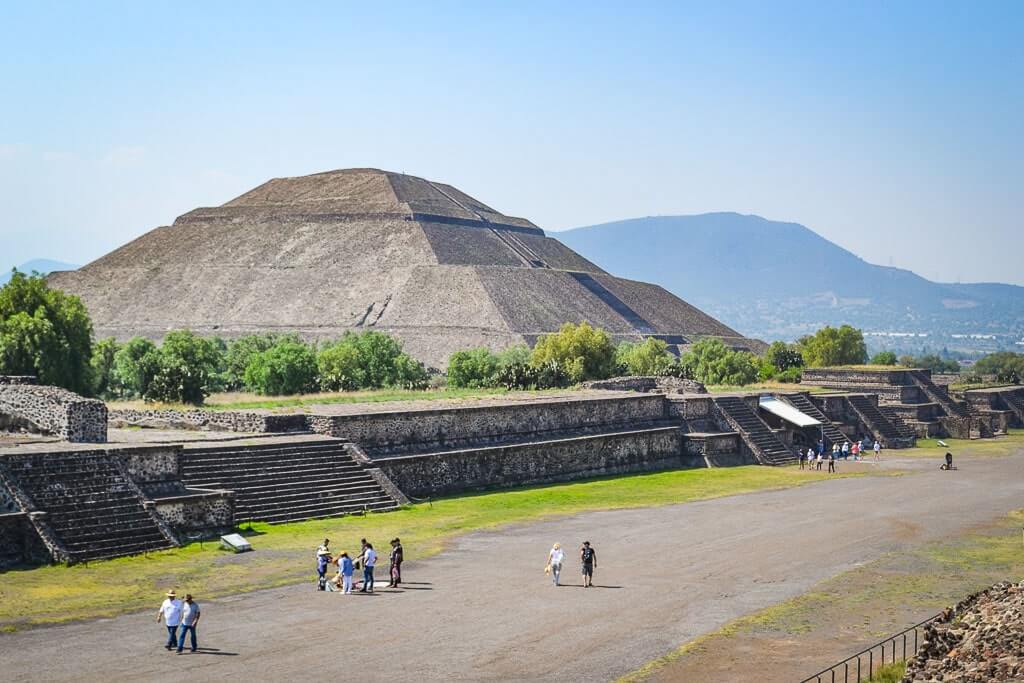
The Pyramid of the Sun is one of the most significant structures within the ancient city of Teotihuacan. Built around 200 CE, it stands as the largest structure in Teotihuacan and one of the largest in Latin America. It is 216 feet (65 meters) tall.
The Pyramid of the Sun is one of the most fascinating pyramids to visit in Mexico City primarily due to its historical significance and architectural brilliance.
Its size is awe-inspiring. In the ancient times, the construction of the Sun Pyramid marked a significant milestone in Teotihuacan’s development. The monument symbolized Teotihuacan’s rise as a burgeoning urban and political center in Mesoamerica.
Archaeological excavations at the Pyramid of the Sun have revealed a wealth of information about the Teotihuacan civilization.
In the early 1970s, a system of caves and tunnels was discovered underneath the pyramid. This cave, thought to be a natural formation, was filled with artifacts such as pottery and obsidian. This points to the fact that the Sun Pyramid was probably a place of religious and ceremonial significance. Research suggests that this was probably a shrine for the Mesoamerican God of Fire, Xiuhtecuhtli or Huehueteotl.
The pyramid’s name was later given by the Aztecs when they discovered the city in the 1300s. The historical prominence of the Pyramid of Son lies not only in its size and grandeur but also in its religious significance by virtue of being a shrine for an important native deity.
Tours that might interest you.
Pyramid of the Moon
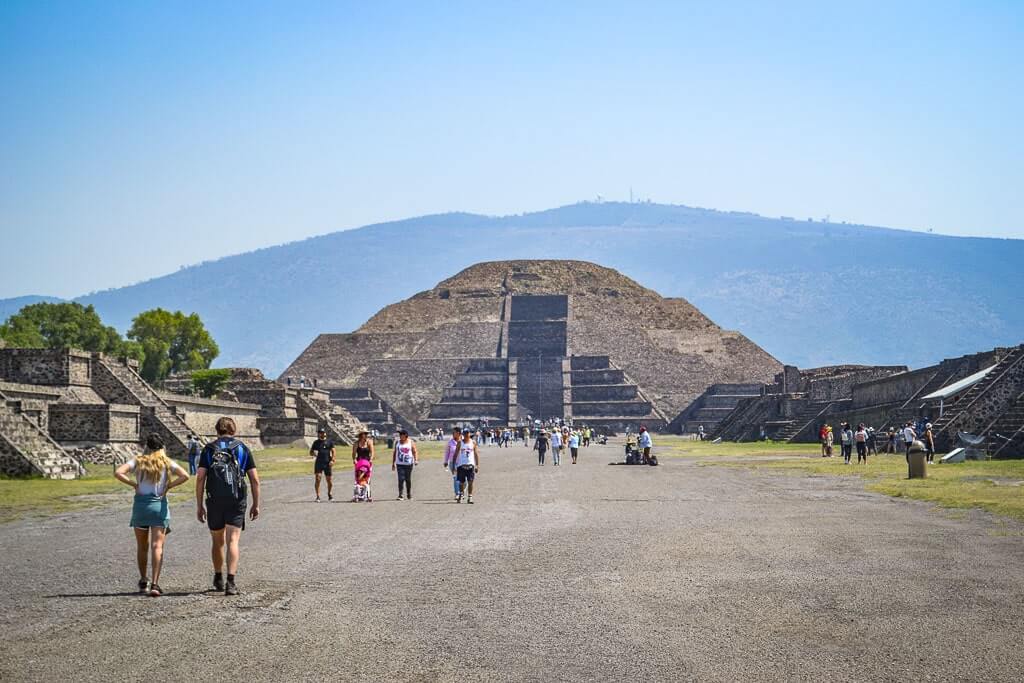
The Pyramid of the Moon is another significant pyramid located in the ancient city of Teotihuacan. It flanks the northern end of the Dead Man’s Avenue.
Constructed in several stages between 100 – 450 CE, the Moon Pyramid is the second-largest pyramid within Teotihuacan.
In its hey day, the pyramid was assigned a very important task. It served as a ceremonial and ritualistic center, where offerings were made to deities and ancestors. Animals and humans were regularly sacrificed and buried here.
Archaeological excavations at the Pyramid of the Moon have yielded a rich trove of artifacts. Among the most significant discoveries are several tombs that contained the skeletons of sacrificial victims, animals, and birds. These tombs also contain a variety of offerings such as greenstone figurines, obsidian blades, and intricate shell jewelry, likely placed as part of funerary rituals.
Latest research tells us that the pyramid could have been used to bury soldiers and war victims, which points to Teotihuacan’s involvement in wars and growing military power.
The pyramid aligns with the Cerro Gordo to the north, a mountain that was of great significance to the Teotihuacanos due to its association with the moon and the water god.
Tours that might interest you.
Feathered Serpent Pyramid

The Feathered Serpent Pyramid, also known as the Temple of Quetzalcoatl, is one of the most renowned structures in Teotihuacan. It flanks the southern end of the Avenue of the Dead and has six levels.
The monument is named for its intricate carvings of Quetzalcoatl, the feathered serpent deity revered in numerous Mesoamerican cultures. These carvings dot every level of the pyramid and are probably one of the oldest ones of the winged deity.
In 2003, archeologists discovered a network of tunnels under the Feathered Serpent Pyramid. A collection of sacrificial offerings, including jade statues, obsidian blades, and crystals were unearthed. Of significant interest were the greenstone statues, wearing garments and beads. They probably represent the oldest shamans of Teotihuacan who guided pilgrims to the sacred city.
Archaeologists believe that the Temple of Quetzalcoatl was built around the 2nd century CE, serving as a significant religious and political center. But it soon lost its significance when people started opposing the Teotihuacan rulers and the ideology of Quetzalcoatl. The construction of an Adosada platform right in front of the temple, blocking all view of the Feathered Serpent carvings, testifies this.
Today, you can no longer climb the Temple of Quetzalcoatl but you can scale the Adosada platform and check out the exquisite carvings.
Tours that might interest you.
Iconic Aztec Pyramids inside Mexico City
Templo Mayor – The Double Pyramid of Tenochtitlan
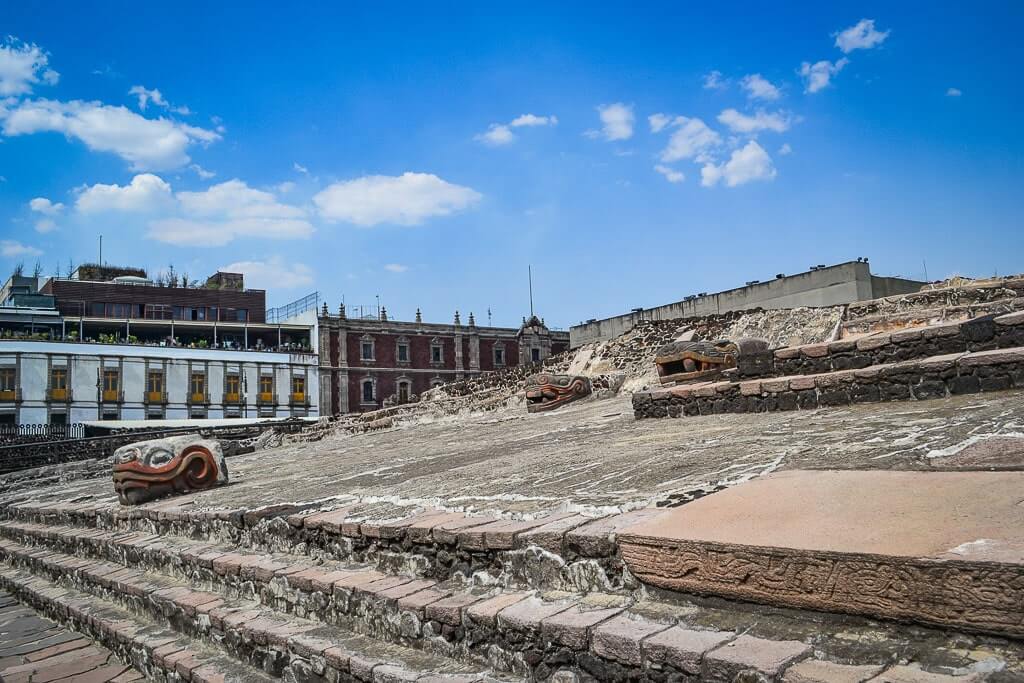
The Templo Mayor, located in the heart of the Historic Center, is one of Mexico City’s most important pyramids.
Constructed in the 14th century by the Aztecs, it once served as the primary temple for their religious capital, Tenochtitlan. The temple was a central place of worship for the Aztec deity Huitzilopochtli, the god of war, and Tlaloc, the god of rain and agriculture, signifying the Aztecs’ deep reverence for the forces of nature.
The Dual Pyramid
Templo Mayor was a dual pyramid – an evolution in pyramid architecture that we find in several Aztec ruins near Mexico City.
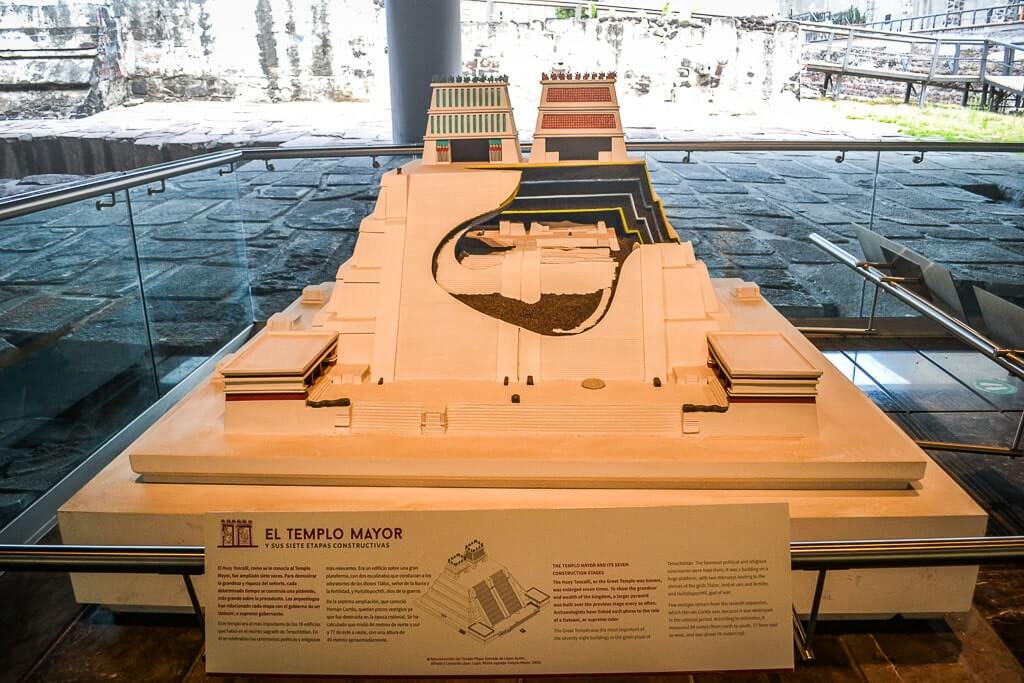
Much of Templo Mayor was destroyed by Spaniards when they took over Tenochtitlan in 1521. The stones and debris were used to build colonial buildings like the Metropolitan Cathedral and the National Palace.
However, visitors can still visit a small part of Templo Mayor in the historic center. The site also has a couple of museums which provide a deeper understanding of Aztec civilization through the multitude of archaeological artifacts on display.
A variety of objects such as stone sculptures, ceramic vessels, and ritual offerings were unearthed at Templo Mayor. The most notable among these is a massive monolithic sculpture of the Aztec goddess Coyolxauhqui, the sister of Huitzilopochtli.
Other fascinating finds include a rich array of ritual offerings such as seashells, coral, jade, obsidian, and even remains of animals and birds. Intriguingly, archaeologists have also found evidence of human sacrifices, reflective of the Aztecs’ complex religious practices.
Tours that might interest you.
Private Tour to Templo Mayor in Mexico City
Tlatelolco Archeological Zone
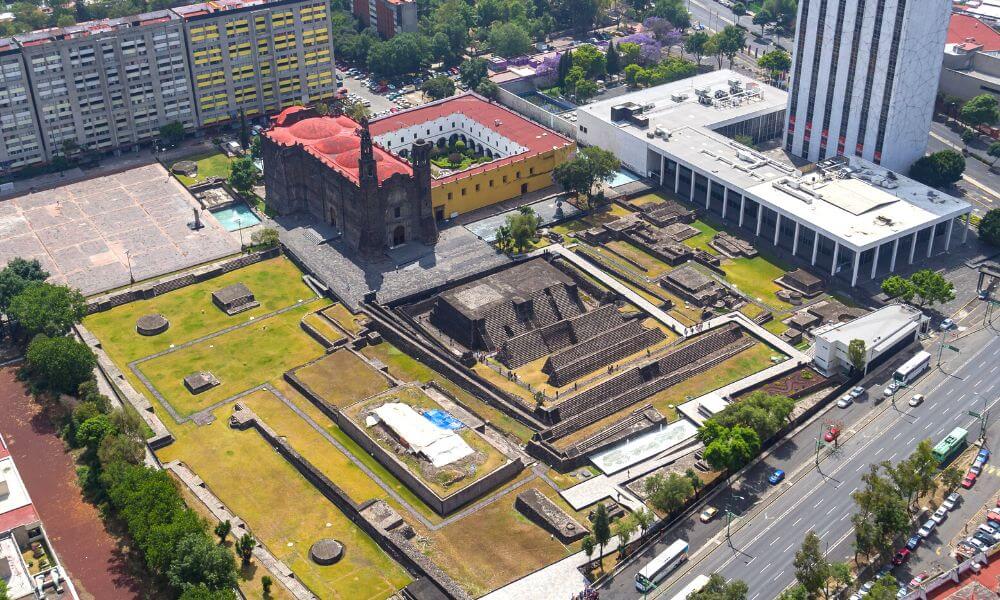
[Image courtesy: Ulrikestein via Canva Pro]
The Tlatelolco Archeological Zone in Mexico City is a site of immense historical significance. It was once the heart of the pre-Columbian city-state of Tlatelolco, a thriving commercial and cultural hub in the Aztec Empire. The Tlatelolco market was one of the largest in Mesoamerica, attracting traders from far and wide.
Tlatelolco was a rival state of Tenochtitlan during Aztec times. It was finally captured and absorbed into Tenochtitlan in 1473 when the infamous Battle of Tlatelolco was fought.
Today, the ruins of the Tlatelolco pyramid and the city stand as a reminder of Mexico’s rich and complex past, its Mesoamerican history, battles, wins, and losses.
Its location at Plaza de las Tres Culturas, where the pre-Hispanic, Spanish colonial, and the modern era intersect is pretty interesting too. Here, visitors can experience the fascinating convergence of epochs, witnessing the layers of Mexico’s history all in one location.
Tours that might interest you.
Tlatelolco, Teotihuacan & Tequila Tasting from Mexico City
Impressive Toltec & Olmec Pyramids outside Mexico City
Great Pyramid of Cholula
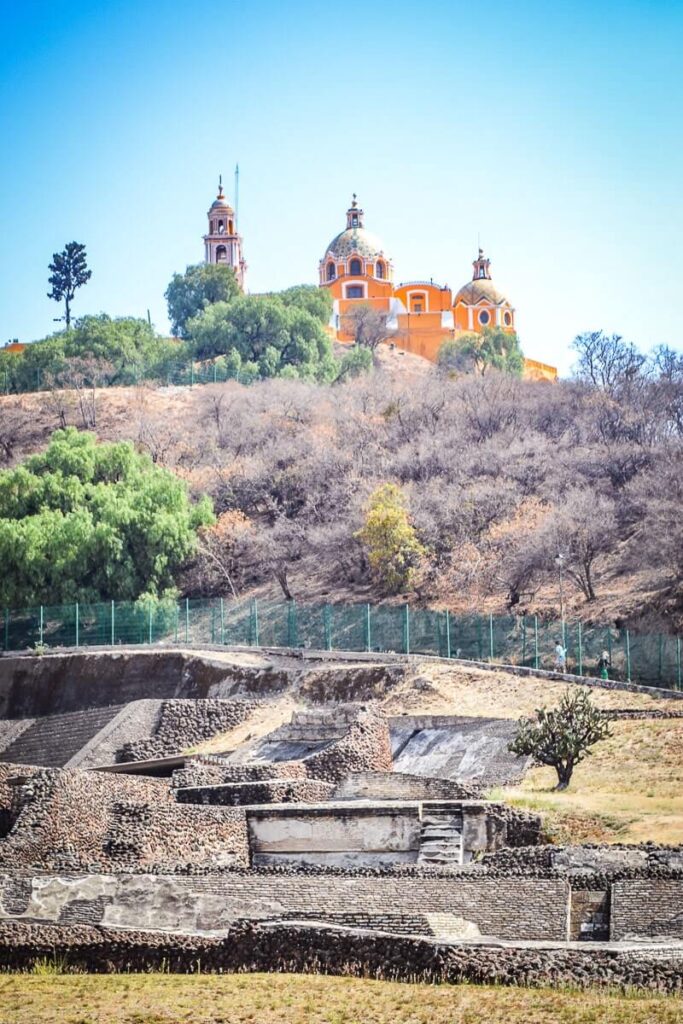
The Great Pyramid of Cholula, located in the Mexican state of Puebla, is a marvel of ancient Mesoamerican architecture and engineering. It is the largest pyramid in the world in terms of volume, even surpassing the Great Pyramid of Giza in Egypt.
Despite its name, it does not resemble the classic idea of a pyramid due to the growth of vegetation and natural elements concealing its stepped structure. Archaeological studies indicate that its construction began around the 3rd century BCE by the Olmecs, and it was continuously expanded over the next thousand years. The final structure was probably built by the Toltecs in the 10th century.
The pyramid is deeply integrated with the cultural and spiritual life of the ancient Cholula civilization, serving as a religious and ritualistic center.
Walking through the labyrinthine tunnels within the pyramid transports visitors back in time, providing an intimate glimpse into the rituals and lifestyles of the past. [The tunnels have been closed since COVID-19. Hopefully, they’ll reopen soon!]
Further, a stroll through the archeological zone and the Sitio Museum reveals many secrets of Cholula’s pre-Hispanic past. Large Olmec heads, religious altars, staircases leading to nowhere, and colorful murals tell us a hundred stories. Perhaps, the most interesting one is the mural of the pulque drinkers that was found on site which points to the ancient heritage of the traditional Pueblan drink.
In addition, the Church of Our Lady of Remedies perched atop offers panoramic views of the city of Puebla. The combination of the pyramid’s historical significance, the charm of the church, and the breathtaking view makes the Great Pyramid of Cholula near Mexico City a must-visit site for any traveler.
Tours that might interest you.
Cholula Pyramid & Puebla Small Group Tour from Mexico City
Tula Pyramid
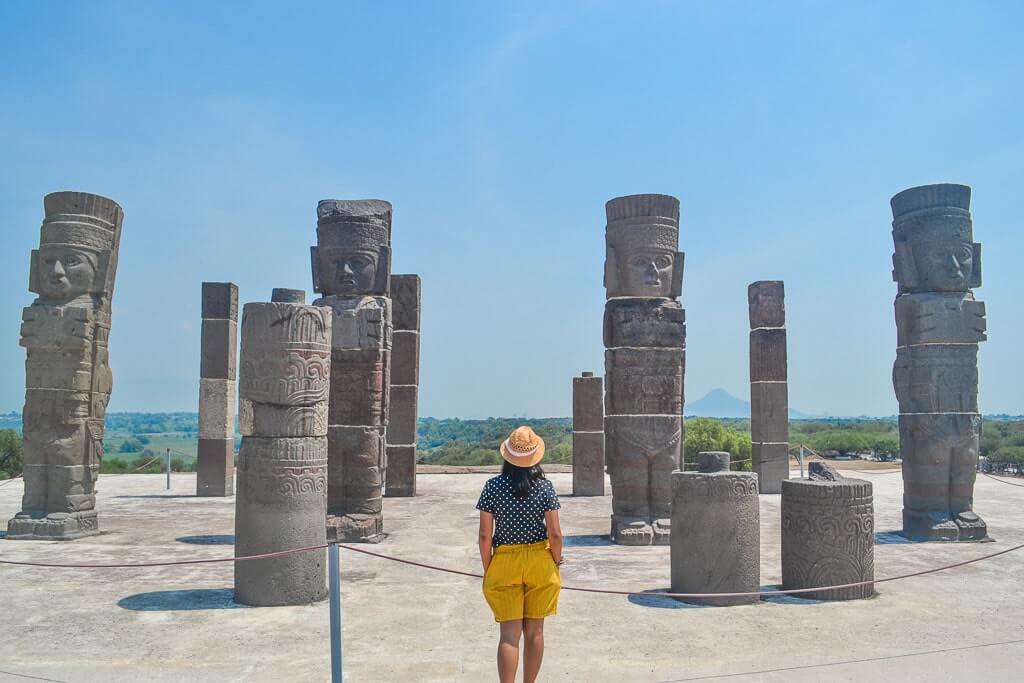
The Tula Pyramid, also known as the Pyramid of Quetzalcoatl, is a historical gem located in Tula.
Located about 40 miles from Mexico City, the Tula Pyramid hails from the post-classic period of the Mesoamerican timeline. It was built between the 9th and 12th centuries, when the Tula city was the capital of the Toltec Empire.
The Mexican Pyramid of Tula is famous for its four colossal Atlantean statues—mammoth stone figures dressed as Toltec warriors. The statues depict warriors adorned with butterfly breastplates, sun-shaped shields, and feathered headdresses, resembling the attire of the Toltec military.
In addition to the statues, archaeologists have unearthed a variety of stone carvings and obsidian tools bearing religious and cultural motifs. These carvings showcase the Toltecs’ artistic flair and provide insights into their belief system. Furthermore, it points to the importance of Tula as an growing obsidian trading center due to its proximity to obsidian mines.
Tours that might interest you
Private Tour from Mexico City to the Pyramids of Tula and Teotihuacan
Interesting Facts about Mexico City Pyramids
- The pyramids of Mexico City have several superlatives to boast of. The Pyramid of the Sun at Teotihuacan is one of the tallest pyramids in the western hemisphere and the world. Cholula’s Great Pyramid is the largest pyramid in the world by volume.
- Many of Mexico’s pyramids are dedicated to the ancient Mesoamerican God, Quetzalcoatl. Quetzalcoatl was the Feathered Serpent God of pre-Hispanic cultures.
- You’ll notice that many of these pyramids were built over centuries. Civilizations came and went and they kept adding to the pyramids, thereby making them bigger in size. Therefore, researchers have found traces of multiple epochs at several pyramids. Case in point – Pyramid of the Moon and the Great Pyramid of Cholula.
Mexico City Pyramids FAQ
Yes, there are several pre-Hispanic pyramids in Mexico City, some of them dating back to the 1st century BCE. The three pyramids of Teotihuacan are Mexico City’s most famous ancient structures.
Yes, a visit to the pyramids in Mexico City is absolutely worth it because these ancient structures let you peel through multiple layers of Mexico’s history and allow you to learn about lost Mesoamerican civilizations.
Ancient Mesoamerican civilizations including the Aztecs, the Toltecs, the Olmecs, and the Teotihuacanos built the pyramids in Mexico City.
The pyramids in Mexico City are famous because they are massive, awe-inspiring structures that were built thousands of years ago as shrines to pre-Hispanic deities and showcase the expert engineering skills of ancient civilizations that inhabited the region.
Loved this Mexico City Pyramids Guide? Pin it for later!



One thought on “7 Fascinating Mexico City Pyramids To Visit In 2024”